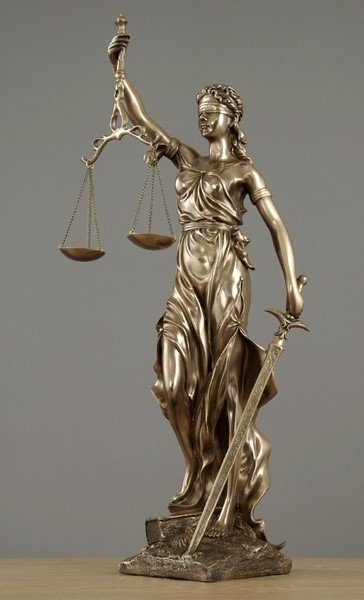Lady Justice
Most of us are familiar with the depiction of justice as a lady, typically wearing a blindfold and holding a balance in one hand and a sword in the other. She is called Justicia, the personification of justice in Roman art, and is linked with Themis, the Greek goddess over divine law and order. In Roman mythology, Justicia represents one of the four virtues (Justice), along with Prudence, Fortitude, and Temperance. In Greek mythology, Themis was a daughter of Uranus (a personification of heaven) and Gaea (a personification of earth) and served as a messenger, delivering rules of conduct established by the elder gods. She taught mankind the primal laws of justice and morality which included precepts of piety, hospitality, governance of affairs, conduct of assembly, and offerings to various gods. Serving as a counselor to Zeus, king of the gods, Themis was responsible for notifying him when the rules of conduct were breached (she was also one of Zeus’ earliest wives).
The blindfold for Lady Justice is an invention of the 16th century, thought to have been added to signify the tolerance or ignorance of the legal system to abuse and injustice. Since that time, however, it has come to symbolize the impartiality of justice: she could discern between good and evil and pass a just sentence without being influenced by what she saw with regard to the accused or the accuser. She could not be swayed by richness or poverty, by power or weakness, by title or privilege. Each case would be judged equally according to its merits rather than the circumstances of the parties involved.
The “scales of justice” are carried to represent fairness in weighing the evidence of a case. The common interpretation is filtered through the tenets of the Age of Enlightenment (17th and 18th centuries), which stressed reason, logic, criticism, and freedom of thought, implying a mechanistic process in determining whether the scales would tilt towards innocence or guilt. They have also represented the balance of individual needs against those of society.
The sword symbolizes authority to carry out a sentence and is reminiscent of supreme leaders and monarchs of older times. It is usually unsheathed, indicating that justice will be swift, and double-edged, indicating that it can cut at either party with equal strength. As a symbol of protection, individuals are meant to feel safe under the authority of the law or to fear it if they intend to do harm.
The symbol of justice serves as a link between natural law and rational law, incorporating the culture of the divine with the culture of civil society and defending the inherent right of the individual by recognizing the responsibilities of society and of law. She reminds us that fair and equitable treatment in matters of law is one of our highest virtues, and that this value also extends to simple matters of human interaction: how we treat one another. We cannot separate ethics or morality from law, but there are important distinctions to understand in order to build a better appreciation of our responsibilities as engineers and as human beings.
